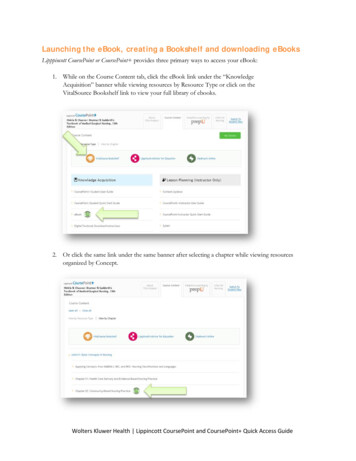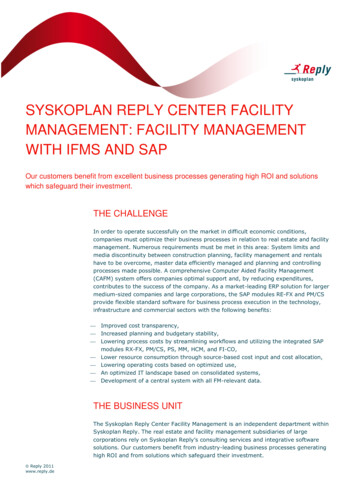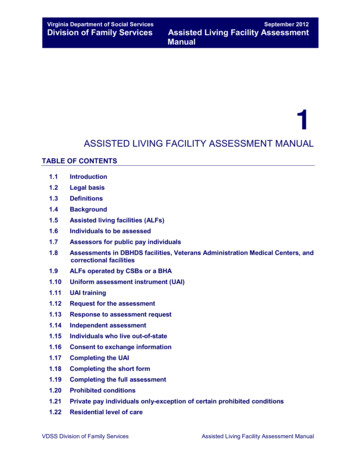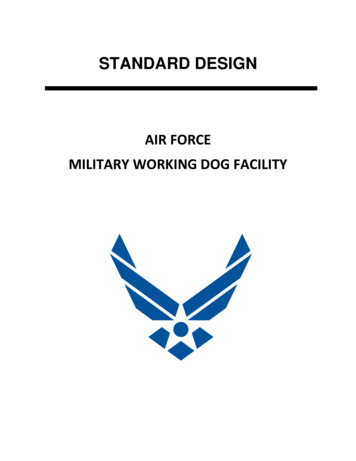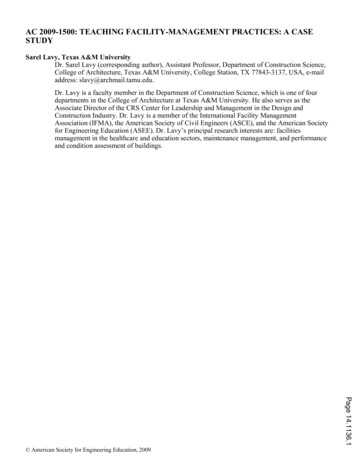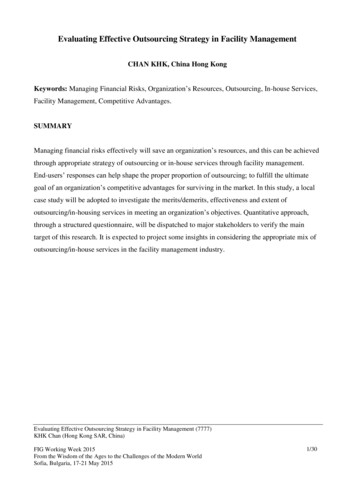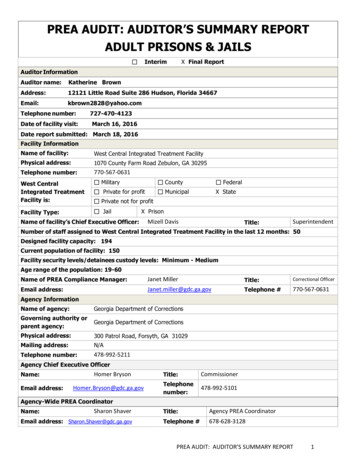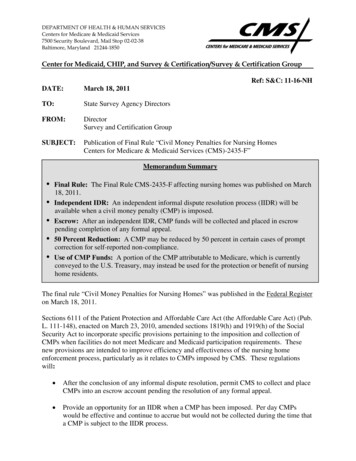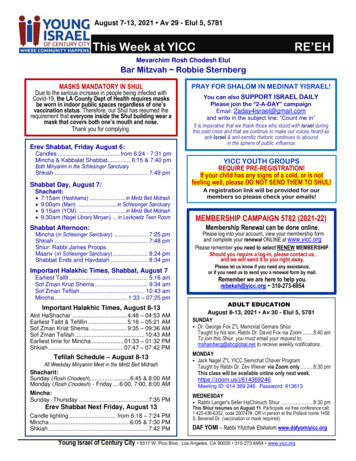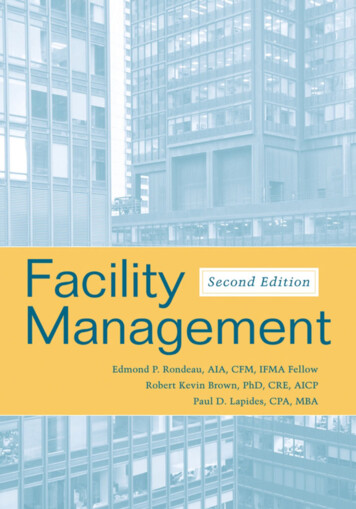
Transcription
FacilityManagement
FacilityManagementSecond EditionEdmond P. Rondeau, AIA, CFM, IFMA FellowRobert Kevin Brown, PhD, GRE, AICPPaul D. Lapides, CPA, MBAJohn Wiley & Sons, Inc.
This book is printed on acid-free paper.Copyright 2006 by John Wiley & Sons, Inc. All rights reservedPublished by John Wiley & Sons, Inc., Hoboken, New JerseyPublished simultaneously in CanadaNo part of this publication may be reproduced, stored in a retrieval system, or transmittedin any form or by any means, electronic, mechanical, photocopying, recording, scanning, orotherwise, except as permitted under Section 107 or 108 of the 1976 United States Copyright Act, without either the prior written permission of the Publisher, or authorizationthrough payment of the appropriate per-copy fee to the Copyright Clearance Center, 222Rosewood Drive, Danvers, MA 01923, (978) 750-8400, fax (978) 646-8600, or on the Web atwww.copyright.com. Requests to the Publisher for permission should be addressed to thePermissions Department, John Wiley & Sons, Inc., 111 River Street, Hoboken, NJ 07030,(201) 748-6011, fax (201) 748-6008.Limit of Liability/Disclaimer of Warranty: While the publisher and the author have usedtheir best efforts in preparing this book, they make no representations or warranties withrespect to the accuracy or completeness of the contents of this book and specifically disclaim any implied warranties of merchantability or fitness for a particular purpose. Nowarranty may be created or extended by sales representatives or written sales materials.The advice and strategies contained herein may not be suitable for your situation. Youshould consult with a professional where appropriate. Neither the publisher nor the authorshall be liable for any loss of profit or any other commercial damages, including but notlimited to special, incidental, consequential, or other damages.For general information about our other products and services, please contact our Customer Care Department within the United States at (800) 762-2974, outside the UnitedStates at (317) 572-3993 or fax (317) 572-4002.Wiley also publishes its books in a variety of electronic formats. Some content that appearsin print may not be available in electronic books. For more information about Wiley products, visit our web site at www.wiley.com.Library of Congress Cataloging-in-Publication Data:Rondeau, Edmond P.Facility management / Edmond P. Rondeau, Robert Kevin Brown, Paul D. Lapides. 2nd ed.p. cm.Includes bibliographical references and index.ISBN-13 978-0471-70059-3 (cloth)ISBN-10 0-471-21061-7 (cloth)1. Real estate management. 2. Facility management. I. Brown, Robert Kevin.II. Lapides, Paul D. III. Title.HD1394.R66 2006658.2—dc222005010713Printed in the United States of America10 9 8 7 6 5 4 3 2 1
D EDICATEDTO:The hardworking, knowledgeable, and skilled facility professionals who acquire,plan, design, construct, support, maintain, and manage corporate facilities to helptheir customers and organizations succeed and excel.The in-house customers who require and accept professional assistance andentrust their facility service providers with corporate resources and timely confidential information to meet their strategic business requirements.The suppliers, vendors, contractors, and consultants who provide high-quality,timely, creative, and cost-effective services to help their facility professional clientssucceed and excel.The bosses and corporate officers who support and provide their facility professional staff with the responsibility, authority, and resources to execute their duties.The students, teachers, and educational organizations who sustain a growingknowledge and research base of facility management information and are thefuture of the profession.Keep up the good work!And Sarah D. Rondeau, wife of Ed Rondeau.
ForewordNot until the 1980s did facilities management (FM) come into its own. Eventhough FM had always been around in one form or another, it lacked a focus,even a name. It did not command a presence either within the organization orwithout. In fact, practitioners didn’t know that “someone else does what I do,” asthe FM vice president of a Midwest bank told me in 1980.Indeed, the 1980s can be considered the decade of facilities management. Associations of professional FM practitioners were formed, colleges and universitiesdeveloped FM degree programs, publications exclusively for FMs appeared for thefirst time, and manufacturers and consultants hopped on the FM bandwagonwith marketing plans to serve this newly identified buyer with clout.In short, the sleeping discipline emerged from its cocoon and matured tobenefit the corporation and its employees. Facilities managers turned theirattention to critical issues, from human factors to new technologies, energyconservation to indoor air quality, and the means to integrate them all in thetotal workspace.But by the end of the decade, the flourishing economy took a nosedive with arecession unlike those of the past. The recession of the 1990s was deeper andsteeper, and business is seemingly unable to make a fast rebound to anything wemight consider normal. Reflecting business in transition, the early 1990s saw newwords enter corporate America’s lexicon: reengineering, restructuring, reinventing, and downsizing, rightsizing, smartsizing. No matter what the euphemism,employees were pink-slipped by the tens of thousands.Nor were facilities managers immune to wholesale layoffs. In some cases, theentire FM department was disbanded, giving meteoric rise to outsourcing as aword and a business concept. American business was indeed in the throes of transition, and FMs struggling for survival diligently searched for new means to meetbelt-tightening mandates with bottom-line measures. In response came such concepts as hoteling, telecommuting, virtual offices.The first five years of the twenty-first century have seen economic recessionafter 9/11 and the growth of business mergers have continued to force reconsideration of many long-accepted practices. As economists forecasted a slow recoveryafter 9/11 American business continue to pull out of this long slump.In the 2000s, facilities management executives are facing even greater pressuresto sharpen their strategic skills to match those of every other top executive in thecorporate structure. As a result, educational tools will be in demand by those eagerto move ahead. This book by three highly regarded professionals serves as a solidfoundation for the principles and practice of facilities management. The challengesvii
viiiForewordahead may be great, yet meeting those challenges can be professionally and personally rewarding.A NNE FALLUCCHIIFMA FellowEditor Emerita and Founding Editor,FACILITIES DESIGN & MANAGEMENT
PrefaceThe facility management profession has been and continues to evolve as an inhouse service to corporate employers. Many experienced corporate facility management professionals and product and service providers have been working toimprove the profession, information, products, and services they provide their inhouse customers and clients. A 1991 market study by a national real estate services group stated, “More than seven billion square feet of building space and fourquadrillion square feet of land are owned by corporate America. It is often themost valuable asset on U.S. company balance sheets. As the nation’s businessescontinue to undergo a fundamental restructuring—through mergers and acquisitions, decentralization, new technologies, changing markets and tightening profits—the pressure is on to better manage corporate facilities and make thoseassets work harder.”1As local, national, and global economies and services change, providing information and services that lead to informed and financially sound decisions aboutthese assets becomes even more important in protecting them and improving thevalue of your corporation. Ideally, this book will help you and your company protect and more effectively and efficiently use its assets to improve shareholdervalue.This book contains up-to-date information about the evolving facility management profession that will help facility professionals and their service providersmeet the current and long-range challenges and opportunities they face.Among the book’s outstanding features are its hands-on approach and manyrelevant exhibits, including samples, policies, procedures, forms, and examples.This book takes a practical approach to the activities facility and outsource professionals must address to successfully manage their responsibilities and career.This book provides the facility professional with a detailed review of facilitymanagement issues. It does not provide a detailed review of or instructions regarding legal details, issues, or requirements; the facility management professionalshould review and address these topics with corporate or outside legal counsel.The book is divided into ten chapters designed to help you look at the servicesand issues facility professionals and consultants face in the ongoing cycle of successfully meeting their customers’ requirements and completing facility management assignments.Chapter 1 provides an overview to facility management, including a brief discussion of the evolution of the profession, definitions, organizational and personnel1ArthurAndersen & Co., Real Estate Services Group, Marketing Publication, 1991, p. 2.ix
xPrefaceissues, ethics, the facility management mission, you and your customer, negotiation strategies, service level agreement (SLA), total quality management (TQM),balanced scorecard, the Sarbanes-Oxley Act of 2002, LEED, and the Americanswith Disabilities Act (ADA).Chapter 2 presents information on long-range and annual facility planningwith reference to complementing the business plan and synchronizing corporateplanning. It also looks at corporate facility planning, strategic planning, theannual operating plan, the long-range plan, strategic real estate and facility planning, strategic corporate facility management information, and the disposition ofassets.Chapter 3 reviews facility financial forecasting and management. Areas covered include the annual operating plan, the long-range plan, appropriationsrequest, trend and ratio approach, capital budgeting evaluation, financial andfacility alternatives, the development and use of capital project tracking, disposing of assets, and outsourcing.Chapter 4 examines real estate considerations, analysis, and planning. Withthe vast amount of corporate resources and funds invested in corporate realestate and their associated legal commitments, it is important that facility professionals understand the responsibilities and objectives of the real estate function,best practices in corporate real estate management, issues to review and analyze,real estate and facility inventory, site criteria considerations, determination ofcustomers’ requirements, selection of a real estate broker, principal analytical andtransactional activities, acquisition, site evaluation criteria, customers’ site evaluation criteria, environmental and due diligence issues, and the legal documentreview process.Chapter 5 reviews architectural and engineering planning and design: development of design requirements and layout, design firm selection process, programming and design, LEED (Leadership in Energy and Environmental Design),budgeting, contract document review, bidding the project, closing and costs, building programming and design illustrated, and campus and high-rise office concepts.Chapter 6 provides interior programming and space-planning information. Itconsiders space and furnishing standards, national purchasing contracts, spaceprogramming, alternate project delivery systems, ergonomic and life safetyissues, additional planning and design requirements, the need and requirementsfor a facility management system (FMIS), and work environment trends thatinfluence space and how people work.Chapter 7 discusses construction and renovation work such as capital andchurn projects; permitting, reviewing, and awarding the construction contract;the preconstruction meeting; construction and renovation; project costs; the certification of occupancy and the punchlist; owner-furnished items; relocation; buildto-suit concerns; new paradigms; and private funding initiatives the FM mustface and manage.Chapter 8 considers the many details of facility maintenance and operationsrequirements. It reviews the importance of maintenance and operations, its goalsand alternatives, time facility maintenance management function, managementplanning process, managing the physical asset, intracompany and customer relations, financial reporting and controls, administrative responsibilities, and marketing and leasing owned and leased facilities.
PrefacexiChapter 9 provides an overview of general administrative and technology services: telecommunications and computer integration, security and safety in light of9/11, disaster avoidance and recovery, records management, furnishings andequipment inventory, mail and copy center services, audiovisual equipment services, conference room scheduling, food and beverage service, and recycling andconfidential destruction services.Chapter 10 examines integrated asset management, technological changes,communication and leadership, successful facility management, and the anticipated evolution of the FM profession. Topics reviewed include hands-on experience, education, and traditions.We hope that after you read this book you will share with us your thoughtsand comments about additional material and exhibits that should be included inthe next edition. Also, we are interested in learning about your facility management experiences, trends, rules of thumb, and other relevant information. To communicate errors, suggestions, and experiences to us, please contact our publisher:John Wiley & Sons, Inc., Professional & Trade Division, 111 River Street, Hoboken, NJ 07030.Thank you for your support; we look forward to hearing from you.Atlanta, GeorgiaE DMOND P. R ONDEAUR OBERT K EVIN B ROWNPAUL D. L APIDES
AcknowledgmentsThe authors acknowledge and thank the following professionals, in-house customers, and corporate clients whose experience, writing, speaking, and sharingcontributed to many of the concepts, ideas, and experiences utilized in the development, realization, and evolution of the facility management profession andpractice.Bill Adams, Project Management; Parkash Ahuja; Keith Alexander, IFMA Fellow, Centre for Facilities Management, UK; David Armstrong, IFMA Fellow, Armstrong Associates; Alvin Arnold, BDO Seidman; Bill Back, CFM, IFMA Fellow;David Baer, UPS Supply Chain Solutions; Pat Bailey, GSA Real Estate Sales;Diane Barnes, Wilkhahn, Inc.; Dr. Franklin D. Becker, Cornell University;Katleen Beeckmann, CoreNet Global (Belgium); Charles Bennett, CPA; SusanBiggs; Stephen Binder, Cushman & Wakefield; Michael Bourque, Earl R. Flanshtirgh & Associates; Rebecca Bray, UPS Supply Chain Solutions; RobertBrosseau (Canada); Richard Burroughs, Applied Software; Derek K. Butcher,Centre for Facilities Consultancy (UK); Malcolm Campbell (Australia); DeborahG. Carlston, Synnax Corporation; Alan Clayton, UPS Supply Chain Solutions;Roy Cloudsdale, Johnson Controls World Services; Peter A. Conlin, CFM; McKinley Conway, Conway Data; Dick Cooper, CFM, IFMA Fellow; David Cotts, CFM,IFMA Fellow (retired); Kreon L. Cyros; Marvin Dainoff, M. Dainoff Associates;John Diefenbach, AIA, JIA, PAE International (Japan); Ben DeVries; JeffDimond; R. Landon Doggett (retired); John Dues; Dr. Francis Duffy, DEGWArchitects (UK); Marty Dugan; Raymond G. DuPont; Lawrence L. Edge, Medallion Group LLP; Behrooz (Ben) Emam, AIA, CFM; Eleanor Estacio, CoreNetGlobal; Anne Fallucchi, IFMA Fellow (retired); Carol Farren, CFM, IFMA Fellow,Facility Management Worldwide; Rudy Flores; Bruce Kenneth Forbes; John Fox(Australia; retired); Geoff Gidley, Facility Management Solutions Ltd. (UK);George Graves, IFMA Fellow (retired); Robert Gross, IFMA Fellow, Vanguard;Jeffrey Hamer, Asset Direction, Inc.; Philip E. Hammel, Honeywell; Dorothy Harris; Ernesto Hernandez; C. Frederick Hess, CFM, IFMA Fellow; James Hickey,CFM, IFMA Fellow (retired); Gerry E. Higgs, CFM, PE; Melanie Hill, CoreNetGlobal (UK); Ken Hitchcock, Marcus & Millichap; Gerald Hubbard, CFM, IFMAFellow; John Igoe; David Jarman, Price Waterhouse; Lois Johnson; Samuel Johnson, CFM, IFMA Fellow; Diana Jones, The Home Depot; William Joseph; MauryKeiser, CFM, IFMA Fellow (retired); Peter S. Kimmel, AIA, IFMA Fellow; Prentice Knight, CoreNet Global; Sigeru Kuwabara, NTT Power and Buildings(Japan); Alex Lam, CoreNet Global (Canada); Earnie C. Leake, CFM, IFMA Fellow; TaeGoo (Ty) Lee, System-O Consultants (Japan); Scott Levitan, GeorgiaInstitute of Technology; Chad Lewis; Dennis Longworth, CFM, ASAE Fellow;xiii
xivAcknowledgmentsHarry Ludwig, King & Spalding; Erik Lund, IFMA Fellow (retired); Jean Lusso,Kerry Lydon (Belgium); Barry Lynch, AIA; Dr. Josef Mack, Facility ManagementInstitute (Germany); Diane MacKnight, CFM, IFMA Fellow; Professor StephenMargulis, Grand Valley University; Jon Martin, Carter; Mike McGahagin; MaryMcGrath, CFM (Canada); Sandra Moss Mallory, Smith, Gambrell & Russell; JimMoss, Applied Software; Sharon Mount, AIA; Motosugu Nakatsu (Japan); Christine H. Neldon, CFM, IFMA Fellow, St. Paul Travelers; Makato Ogawa, NomuraResearch Institute (Japan); Richard Palmer, CFM; Hazel Pankey, Conway Data,Inc.; Jack Parker, Corporate Space Services; Joel Parker, Conway Data, Inc.;Sterling Pettefer; Norman Polsky (retired); Joy Pooler; Helen Rauch, HelenRauch & Associates; Alex Robertson, Siemens Real Estate, Inc.; J. Peter Ruys,AIA, ASID, Ruys & Company; Mel Schlitt, The Merchandise Mart; MichaelSchley, FM Systems; Dr. William R. Sims, CFM, IFMA; Henry Howard Smith,AIA (retired); Stan Stanton, Huntress Executive Real Estate Search; RichardStonis, Associated Space Design; David Taylor (Australia); Tom Tillman; Dr.Andres F. van Wagenberg, Eindhoven University of Technology (Netherlands);Larry Vanderburgh, BOMI; Duncan Waddell, Corporate Facility ManagementResources (Australia); Ken Walker, UPS Supply Chain Solutions; Ray Wallace;Lei Wu (China); Syd Welch; Martha Whitaker; Barry J. Yach; Don Young, IFMA.The authors further acknowledge and thank the following professional associations and education organizations whose leadership, vision, sharing, research,educational programs, and service to members and students help shape and provide guidance for the evolution of the facility management profession and practice: American Institute of Architects (AIA) American Society of Interior Designers (ASID) American Society of Real Estate Counselors (ASREC) Association National des Responsables de Services Generaux (France) British Institute of Facilities Management (BIFM) Building Owners and Managers Association (BOMA) Building Owners and Managers Institute (BOMI) Business and Institutional Furniture Manufacturers Association (BIFMA) CoreNet Global Danish Facilities Management Association (DFMA) EUROFM Facility Management Association of Australia Limited (FMA) German Facility Management Association (GFMA) Industrial Asset Management Council (IAMC) Institute of Business Designers (IBD) Institute of Real Estate Management (IREM) International Facility Management Association (IFMA) International Society of Facility Executives (ISFE)
Acknowledgmentsxv Japan Facility Management Association (JFMA) National Office Products Association (NOPA) Netherlands Facility Management Association (NEFMA) Norwegian Network of Facility Management (NNFM) Urban Land Institute (ULI)Thanks also to John Czarnecki of John Wiley & Sons, Inc., for his patience andsupport with this second edition.Finally, we wish to thank those professionals and organizational leaders whocare and who persevere in providing a humane, environmentally friendly, safe,and secure work environment for their colleagues, clients, and employees.E.P.R.R.K.B.P.D.L.
About the AuthorsEDMOND P. RONDEAU, AIA, CFM, IFMA Fellow, is the general manager, realestate, in the Real Estate Development Office, where he manages owned andleased property for the Georgia Institute of Technology in Atlanta, Georgia. Previously, Ed was the director of global operations for Conway Data, Inc., an Association Management Company based in the Atlanta, Georgia, area, where he wasresponsible for association management–related assignments primarily outsideof North America. Ed has been responsible for the International DevelopmentResearch Council’s member and chapter development programs, world congresses, and staff for Asia, Australia, Europe, and Latin America regions. Hiswork experience includes serving as the director of consulting services for theIntegrated Facility Management business unit of Johnson Controls, Inc.; as themanager of corporate real estate for Contel Corporation; as the vice president ofproperty management for the National Bank of Georgia; as the vice president ofreal estate and construction for Arby’s, Inc.; as a construction manager for theCoca-Cola Company; and as a staff architect for Auburn University.Ed holds a master’s in business administration in real estate from GeorgiaState University and a bachelor of architecture from Georgia Tech, is a registeredarchitect in Georgia, holds a NCARB certificate, and is a Certified Facility Manager. He was the 1988 president of the International Facility Management Association (IFMA), served as the 1990 chair of the IFMA Foundation, was elected anIFMA Fellow in 1992, and was the 1994/1995 president of the IFMA Real EstateCouncil. He served on the board of directors for the Board Certified in CorporateReal Estate (BCCR), was a member of the IDRC Financial Review Board, was atrustee of the IFMA Foundation, has served as the chair of the Advisory Committee for the Georgia Tech Integrated Facility and Property Management mastersdegree program and is a member of the Core Global Finance Committee.He has worked for spoken on corporate real estate and facility managementissues throughout the United States and internationally, including in Argentina,Australia, Austria, Belgium, Brazil, Canada, China, Cuba, Denmark, Japan, Germany, Hong Kong, India, Italy, Mexico, the Netherlands, New Zealand, Philippines, Singapore, South Korea, Spain, Sweden, Trinidad and Tobago, the UnitedKingdom, and Venezuela. Ed has authored numerous articles and is a coauthor oftwo books on corporate real estate and three books on facility management. He isthe author of numerous facility management and corporate real estate articles,the author of Principles of Corporate Real Estate, a coauthor of Managing Corporate Real Estate and Managing Corporate Real Estate: Forms and Procedures, thecoauthor of the real estate management information system LeaseKiT, and thecoauthor of the capital project budget tracking system CaProKIT. He is the leadxvii
xviiiAbout the Authorsauthor of the book Facility Management, which received the 1997 IFMA Author ofthe Year Award; is coauthor, with Dr. Walther Moselener, of Facility Management2, published in Germany; and is the coauthor of The Facility Manager’s Guide toFinance and Budgeting, for which he received the 2004 IFMA DistinguishedAuthor Award.ROBERT KEVIN BROWN, PhD, CRE, AICP, is president, Robert K. Brown &Associate. He is the chair emeritus of real estate and the originator and formerchairman of the Department of Real Estate, College of Business Administration,Georgia State University. He served previously as corporate director of realestate, Rockwell International Corporation; vice president, Rockwell GraphicsSystems Group; and president, Narland Corporation and Standard PropertyLand Company, wholly owned Rockwell subsidiaries.Dr. Brown holds a bachelor’s degree from the Johns Hopkins University andmaster’s and doctoral degrees from the University of Pittsburgh. A nationallyknown lecturer and consultant on asset management strategies to many Fortune500 companies, he is the codeveloper of the first commercially available PC-basedcorporate real estate asset management system. He is the author of numerousarticles and 11 books on real estate, including Managing Corporate Real Estate,The Real Estate Primer, Essentials of Real Estate, Real Estate Economics, andCorporate Real Estate: Executive Strategies for Profit Making, and is the coauthorof Managing Corporate Real Estate, Managing Corporate Real Estate: Forms andProcedures, and Real Estate Asset Management: Executive Strategies for ProfitMaking. Dr. Brown was the contributing editor of the corporate real estate column in National Real Estate Investor Magazine. He also serves as a member ofthe Asset Management Editorial Board of National Real Estate Investor Magazineand the board of advisors of The Arnold Encyclopedia of Real Estate.Dr. Brown is a member of the American Society of Real Estate Counselors(GRE) and served as a member of its board of governors. He holds membershipsin the American Real Estate Society (ARES); American Institute of CertifiedPlanners (AICP); International Facility Management Association (IFMA); andInternational Association of Corporate Real Estate Executives (NACORE), wherehe served on the board of directors. He served as a member of the board of directors of Underground Festival, Inc., the governing board of Underground Atlanta.More recently, Dr. Brown served an appointment as visiting professor in theGraduate School of City Planning, College of Architecture, Georgia Institute ofTechnology.PAUL D. LAPIDES, CPA, MBA, is a professor of management and entrepreneurship at the Michael J. Coles College of Business at Kennesaw State University(Georgia), where he founded and serves as director of the nationally recognizedCorporate Governance Center.Mr. Lapides is a member of the board of directors of Sun Communities, Inc.(NYSE: SUIT), and the Board of Directors Network, Inc. (BDN), and serves onthe advisory boards of the National Association of Corporate Directors (NACD)and the Newman Real Estate Institute at Baruch College. His business and consulting experience includes advising hundreds of start-up, growth, and midmarket companies, as well as many of America’s Fortune 500 companies.
About the AuthorsxixMr. Lapides is the author of more than one hundred articles and twelve books,including Managing and Leasing Residential Properties; coauthor of ManagingCorporate Real Estate, Managing Corporate Real Estate: Forms and Procedures,Real Estate Investment: Strategy Analysis Decisions; and contributing author ofThe Public REIT Legal Source, Real Estate Investment Trusts, Problem RealEstate, Real Estate Syndication Manual, Real Estate Transactions, and TheArnold Encyclopedia of Real Estate. A frequent speaker at business, professional,and academic organizations, his opinions have appeared in more than 500 publications and on national and local television and radio.Mr. Lapides received a bachelor’s degree with honors in economics from theWharton School of the University of Pennsylvania and a master’s of businessadministration from New York University. Prior to joining the faculty at Kennesaw State University, he was an adjunct professor of real estate at New York University and Columbia University.
Contents123An Overview of Facility Management1DefinitionsOrganizational and Human Resources IssuesEthicsThe Facility Management MissionYou and Your CustomerNegotiation StrategiesTotal Quality ManagementAmericans with Disabilities ActConclusion3827313441466468Long-range and Annual Facility Planning69Long-range Facility Planning ProcessStrategic Facility Management FunctionsSynchronizing Corporate Planning and CorporateFacility ManagementStrategic PlanningAnnual Operating PlanThe Long-range PlanSample—Corporate Facilities ProceduresStrategic Real Estate and Facility PlanningSample—Strategic Real Estate/Facility and Market PolicyStrategic Corporate Facility Management InformationDisposition of ity Financial Forecasting and Management132Annual Operating PlanLong-range PlanAppropriation RequestTrend and Ratio AnalysesCapital Budgeting EvaluationPresent-value ModelRisk Analysis ModelsInvestment Value ApproachFinancial and Facility AlternativesCapital Project Tracking132140140141144147149151151154xxi
xxii456ContentsCapital Project Tracking System Process and SequenceDisposing of AssetsOutsourcingConclusion156160176177Real Estate Considerations, Analysis, and Planning178Responsibilities and Objectives of the Real Estate FunctionBest Practices in Corporate Real Estate ManagementStrategic PlanningIssues for Review and AnalysisReal Estate and Facility InventoryDetermining Your Customer’s RequirementsLease Property Negotiating ChecklistPurchase Property Negotiating ChecklistSample Lease—Proposal LetterSample Purchase—Letter of IntentSite Criteria ConsiderationsSelecting a Real Estate BrokerSample Sales Agency AgreementPrincipal Analytical and Transactional ActivitiesThe Process of AcquisitionYour Site Evaluation CriteriaYour Customer’s Site Evaluation CriteriaEnvironmental and Due Diligence IssuesSample Property Environmental Executive SummaryLegal Document Review ProcessLease Agreement Sample for ABC 222229233234237243244249250260292Architectural and Engineering Planning and Design293Design Requirements and LayoutDesign Firm Selection ProcessSuggestions for Selecting a Design FirmSample—Request for Proposal for Architectural Consulting ServicesProgramming and DesignBudgetingContract DocumentsBiddingClosing and CostsBuilding Programming and Design IllustratedCampus and High-rise Office 8344Interior Programming and Space Planning345Space and Furnishing StandardsSample—ABC Company Furnishing StandardsNational Purchasing ContractsAlternat
planning. It also looks at corporate facility planning, strategic planning, the annual operating plan, the long-range plan, strategic real estate and facility plan-ning, strategic corporate facility management information, and the disposition of assets. Chapter 3 reviews facility financial forecasting and management. Areas cov-
